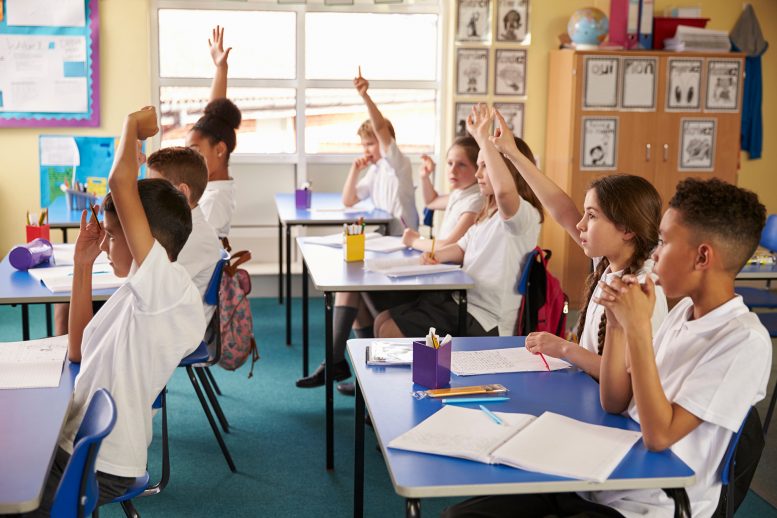
An increase in either the discipline gap or the academic achievement gap between black and white students in the United States predicts a jump in the other, according to a new study published on October 16, 2019, in AERA Open, a peer-reviewed journal of the American Educational Research Association. This is the first published peer-reviewed nationwide study on this topic.
According to the study—conducted by Francis Pearman (Stanford University), F. Chris Curran (University of Florida), Benjamin Fisher (University of Louisville), and Joseph Gardella (Drexel University)—a 10 percentage point increase in the black-white discipline gap in a school district predicts an achievement gap that is 17 percent larger than the average black-white achievement gap. The researchers also found that an increase in the achievement gap between black and white students predicts a larger than average discipline gap.
The study also confirmed previous research that has documented that black and Hispanic students are more likely to face suspension or expulsion for discipline infractions than their white peers, and that black and Hispanic students perform worse on average than White students on standardized assessments.
For the AERA Open study, the scholars analyzed disciplinary and achievement data for grades 3 through 8 in school districts across the United States for the 2011-12 and 2013-14 school years. Disciplinary data came from the U.S. Department of Education’s Civil Rights Data Collection, achievement data from the Stanford Education Data Archive, and socio-demographic information on school districts from the Common Core of Data and the American Community Survey.
“For black and white students, our results support nationally what has been found by earlier research conducted at the state and local levels—that discipline gaps and achievement gaps are two sides of the same coin,” said study coauthor Pearman, an assistant professor of education at Stanford University. “As one goes up, so does the other. Initiatives aiming to close either the racial achievement gap or the discipline gap may have an indirect consequence of closing the other.”
In December 2018, the U.S. Department of Justice and the U.S. Department of Education rescinded federal guidelines put into place in 2014 to address school discipline disparities.
“As a result of this decision, efforts by school districts nationwide to implement policies designed to reduce the use of exclusionary discipline may soon wane,” said Pearman. “Our findings should caution against such moves. Curtailing efforts that address racial inequities in discipline may exacerbate existing inequities in achievement.”
The authors also found a positive relationship between the discipline and achievement gaps between Hispanic and white students, but once other differences between school districts were controlled for—such as income and education levels in the surrounding community—the relationship disappeared.
“We were surprised to learn that the relationship between achievement and discipline gaps among Hispanic and white students was not attributable to the racial discipline gap, but rather to other factors,” said Pearman. “Our results suggest that potential mechanisms connecting suspension to discipline—such as teacher biases or feeling isolated at school—may be most salient for black students.”
“Our findings should encourage parents, teachers, and school leaders to pay attention to racial disparities in discipline and achievement in their school districts,” said Pearman.
“If your district is suspending students of color at higher rates compared to white students, then your district likely is also failing to meet the academic needs of students of color,” Pearman said. “Likewise, if your district struggles to meet the academic needs of students of color relative to its white students, then it will likely have a racial discipline problem too.”
The authors noted there are several approaches that school leaders can use to address either or both gaps. These include teaching approaches that help raise the academic achievement of racial and ethnic minority students, such as culturally relevant teaching and ethnic studies programs, as well as the use of positive behavior interventions and supports and the adoption of disciplinary practices that do not exclude students from school.
###
Reference: “Are Achievement Gaps Related to Discipline Gaps? Evidence from National Data” by Francis A. Pearman II, F. Chris Curran, Benjamin Fisher and Joseph Gardella, 16 October 2019, AERA Open.
DOI: 10.1177/2332858419875440
About AERA
The American Educational Research Association (AERA) is the largest national interdisciplinary research association devoted to the scientific study of education and learning. Founded in 1916, AERA advances knowledge about education, encourages scholarly inquiry related to education, and promotes the use of research to improve education and serve the public good. Find AERA on Facebook, Twitter, and Instagram.









What an ignorant and racist study. Of course kids that don’t listen to their teachers are going to have both academic and discipline problems. No matter what “color” the child is.
Did these researchers think that the most behaved kids are likely to do poor academically, or that the kids that do best academically are likely to misbehave enough to get suspended? Of course there’s a correlation between good discipline and academic achievement, and trying to make that correlation somehow be caused by racist teachers with no evidence is appalling.
The correlation between achievement disparity and discipline disparity is likely to remain strong. given the resistance to change of average performance on tests of reading writing and arithmetic. For example, data for a recent 30-year period indicate the stability of average performance for all students as well as students classified by race/ethnicity, on an internationally recognized test (the SAT).
The table below, showing SAT Critical Reading averages for selected years. Note. Data for Asian-Americans indicate that they’re exceptions to that rule. Their average has improved steadily, and they’re now “leaders of the pack”.
Table 1. SAT Critical Reading average selected years
1987 ’97 2001 ’06 ’11 ’15 ’16
507 505 506 503 497 495 494 All students
524 526 529 527 528 529 528 White
479 496 501 510 517 525 529 Asian
…………………………… . …..436 Hispanic
457 451 451 454 451 448 Mex-Am
436 454 457 459 452 448 Puerto R
464 466 460 458 451 449 Oth Hisp
471 475 481 487 484 481 447 Amer Ind
428 434 433 434 428 431 430 Black
SOURCE: U.S. Department of Education, National Center for Education Statistics.(2012).
Digest of Education Statistics, 2011 (NCES 2012-001), Chapter 2. SAT averages for
college-bound seniors, by race/ethnicity: Selected years,1986-87 through 2010–11
Data for 2015&2016 https://nces.ed.gov/fastfac… Note 2016 data were not provided for Hispanic subgroups.
If SAT averages haven’t changed materially over almost 30 years, despite the effort, time and money expended to improve educational programs for all students, it seems reasonable to assume that we shouldn’t expect any meaningful change in average level of performance in the foreseeable future.